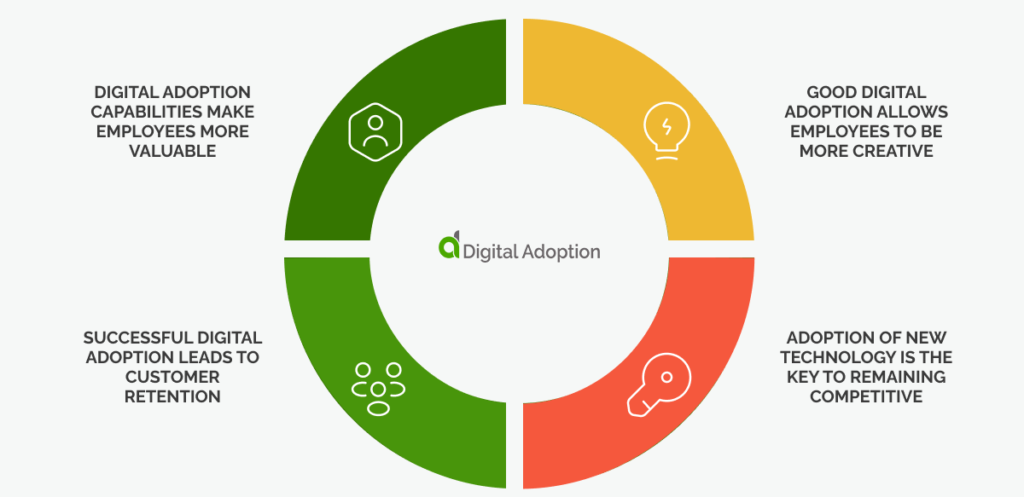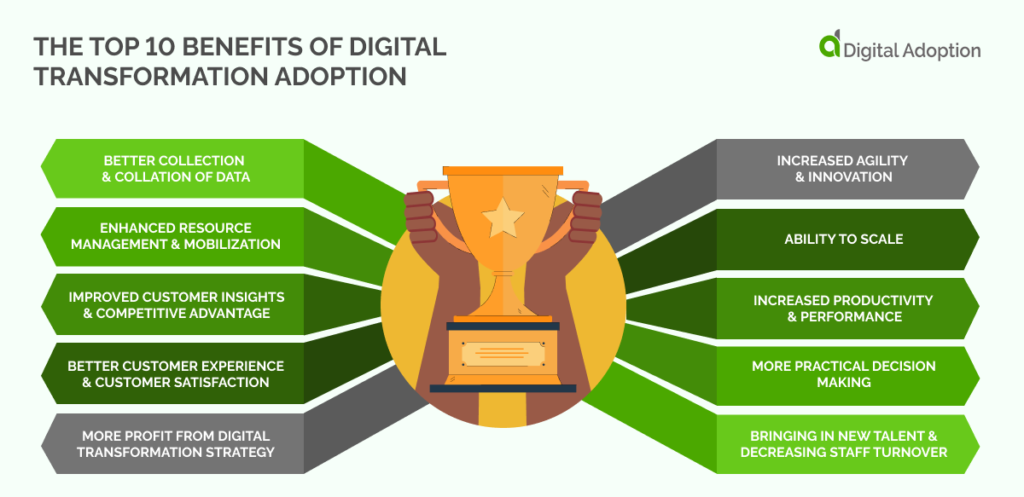Do you remember when you had to be tied to your desk to make a phone call?
Or when forwarding a request meant a trip to the post office? Now, everything you need to do your job successfully is available at the touch of a button. The onset of the digital revolution promised new ways of working for all, but what about those who get left behind in the technological rat race?
One of the most significant advantages of digital adoption is human performance improvement. It allows you to complete important business processes easier, faster, and more efficiently.
Nowhere is this more important than in the workplace. A 2021 study by Foundry found that enterprises can increase revenues by 23% with digital strategies. But to be competitive, you have to be able to adapt fast.
Most of the time, this burden lies on your employees’ shoulders. That’s where adaptability and quick learning become vital for your company to utilize technology to its fullest potential. Digital adoption must be rapid, and it must be complete.
Four Advantages Of Digital Adoption For Every Aspect Of Your Business

1. Digital Adoption Capabilities Make Employees More Valuable
The modern job market dictates that you’re no longer just looking for a salesperson. Instead, you’re looking for an expert in Salesforce; you’re not just hiring an HR manager. You need someone who understands Workday.
You need skilled operators of your organization’s digital tools.
Digital tools are designed to facilitate maximum human productivity. But if employees aren’t familiar with them, that technology quickly becomes a burden rather than an enabler.
That’s why digital adoption tools are gaining traction as a cost-effective and efficient way to onboard employees to unfamiliar digital systems. Successful digital adoption instantly makes employees more practical and, therefore, more valuable to the company.
Good adoption tools will accelerate learning by guiding employees using the system. So no time (or money) is lost on training.
2. Good Digital Adoption Allows Employees To Be More Creative
A study analyzing the work conditions of 127 workers in sales and marketing found that creativity is crucial for job satisfaction.
Because rapid and successful adoption enables employees to achieve more with their time, it also allows them to be free to be more creative.
Moreover, Adobe’s research shows that what employees really want at work is state-of-the-art technology. Why? Because they know that a digitally-forward focus is likely to mean that the workplace has seamless operations, making employees’ lives far more manageable.
3. Successful Digital Adoption Leads To Customer Retention
One of the more visible advantages of digital adoption is that it benefits your customers.
Today’s customer experiences occur online through an app, website, or another platform. A challenging user experience with your customer-facing digital tools can equate to churn.
Customers must adopt these changes rapidly as enterprises introduce new app features, improve their websites, or launch a new digital product.
The sooner your clients or customers feel comfortable with the technology you provide, the better their user experience (UX) will be. This leads to higher levels of customer satisfaction.
Studies show that 80% of cases of customer loyalty arise from solid client satisfaction. Suddenly, digital adoption has become an urgent business priority.
Every customer’s needs and preferences are slightly different. So an adjustable digital system that provides them with a more personalized experience could be a make-or-break situation.
4. Adoption Of New Technology Is The Key To Remaining Competitive
Ultimately, the advantages of digital adoption are that it will help you remain a competitive company.
According to statistics, enterprises in most industries have already implemented digital technologies. And there is evidence of growing profits (from 9% to 26%) in these companies compared to those more conservative with tech upgrades.
The Top 10 Benefits Of Digital Transformation Adoption

Digital adoption improves customer experience and profits in a digital transformation investment. It allows product teams to monitor user behavior and improve the product to match the user’s expectations. Here are the top ten benefits every organization should be aware of when adopting a digital transformation.
- Better Collection & Collation Of Data
Digital adoption platforms (DAPs) improve the data quality when using applications. For example, data validation in a DAP guides users to use the right formats/entries when feeding data into an application. That’s how Thermo Fisher Scientific improved their Salesforce® data quality by 2000%. They used a DAP to prevent more than 3,000 entry errors.
Getting the right data at the point of entry reduces the cost of cleaning the data after collection. In addition, reporting and analytics features in DAPs show how often and efficiently the end-users use the application. Collecting that data helps companies establish how useful the digital transformation is to the end-users and what improvements will reduce user frustrations.
- Enhanced Resource Management & Mobilization
Digital adoption efforts help employees or customers utilize the system’s full capability. When the users know how to use the system, they spend their time doing strategic tasks rather than learning how to use it. We’ll also have fewer support tickets so the support team can focus on customer service strategies.
When an organization adopts a digital adoption platform, they also reduce the training resources. Instead of creating endless videos and articles, the training becomes self-service, on-demand, and within the app. So the company can use resources to achieve other business goals.
For example, before Roche implemented a DAP to offer in-app training for their HR system, they had to create hundreds of e-learning materials in 11 different languages, conduct thousands of live sessions, and provide support. Yet the employees were constantly frustrated by the systems. But after using a DAP to offer on-demand self-help, they spend zero hours on training and have even fewer support tickets. According to Ralph Borer, Roche’s Head of IT Learning Solutions, “Our employees are … more efficient, make fewer mistakes and are happy to self-serve, reducing the need for support.”
- Improved Customer Insights & Competitive Advantage
Successful digital adoption means employees are trained to use analytics tools to gather and interpret customer data using a SaaS application. For example, employees can use a website’s analytics data to understand how customers behave (pages viewed, bounce rate, etc.) and devise ways to increase retention. When your organization understands the customers’ needs, you can give the market exactly what’s needed. It gives the organization a competitive edge over businesses that aren’t getting these customer insights.
Businesses can get even more usable customer insights when they use a digital adoption platform for user onboarding. The DAP shows you complete views of different customer journeys on your platform. The sales and marketing teams can use the information to help users adopt the product better. Such insights helped IBM increase the conversion rate for its digital product 4 times. The DAP helped the teams identify essential milestones in the customer journeys, so they focused on optimizing onboarding in these milestones.
- Better Customer Experience & Customer Satisfaction
Digital adoption tools provide analytics reports that businesses use to learn customer preferences. Then they improve their products and services to match the customer needs. For example, a DAP’s analytics function shows the customers’ journeys in a SaaS application. The product team can see where customers leave the application and improve continuously.
In addition, DAPs provide in-app guidance during onboarding and throughout. So customers don’t need to wait for support ticket responses to complete mundane tasks. And AI-powered tools suggest actions (based on the context) when users are stuck.
Find out how IBM used the WalkMe Digital Adoption Platform to increase customer retention six times and double their revenue.
- More Profit from digital transformation strategy
A successful digital adoption strategy ensures that employees or customers use the new system correctly and to the maximum. And whenever they’re stuck, they get quick support. Digital adoption increases a digital transformation’s ROI.
Consider that when using a digital adoption platform to onboard the HR department on an HCM system, you reduce your training costs by up to 43% while improving the training’s effectiveness. It also increases employee productivity because it keeps frustrations down.
For consumer transformations, digital adoption platforms help users discover and use more products/features. And the data generated from user behavior informs the product teams about friction points. Then the team can continuously improve the product to meet customer expectations.
- Increased Agility & Innovation
Companies leverage technology to remain competitive and relevant in the changing marketplace. For example, organizations using digital twins use real-time data to sense and respond to disruptions. The sooner employees can use these technologies, the quicker the company can respond to changes.
Digital twins are virtual replicas of real-world systems that companies use to test different conditions and build products for the future marketplace. Consider that each of Tesla’s cars has a digital twin that continuously receives real-time data from the real car through sensors. Tracking how the vehicles perform in real-time helps Tesla improve their current cars and design better future models.
Successful digital adoption means employees have learned how to use and make the most of digital technology. Once they use a system to the fullest extent, curious employees with the correct data create innovative solutions.
A streamlined digital adoption process helps organizations adapt to changing technology and increase customer expectations. And digital adoption tools give the user data needed to improve products.
- Ability To Scale
Digital adoption solutions reduce the burden on the support team because training is personalized and contextual. They also reduce the amount of training content because the training is real-time, exactly when the user needs to perform a task. And they automate repetitive tasks.
Such automation helps global organizations roll out new systems and onboard users at scale, like how PWC used a digital adoption solution to onboard 100k users on Salesforce Lightning. They created an interactive training toolkit that enabled their global employees to use the application to its full potential. The intuitive DAP supported the employees full-time while automating repetitive tasks.
By integrating training into daily activities and allowing employees to learn at their own pace, PWC rolls out multiple digital transformations that allow the company to scale.
- Increased Productivity & Performance
Digital adoption reduces the number of clicks users must go through to complete tasks. And providing in-app interactive training improves the training effectiveness. Employees can focus on the strategic business processes when they don’t get stuck completing mundane tasks.
Digital adoption solutions encourage self-service in training. Employees learn at their pace and just when they’re using the platform. The ability to learn new digital technologies on their own empowers employees to do more with new tools. And the fact that employees don’t spend their time on mundane tasks, they can focus on doing valuable tasks that affect the bottom line.
- More Practical Decision Making
The power of digital adoption tools lies in user behavior data. The tools reveal digital adoption challenges like user frustration and friction points. Product teams use the user data to improve the customer experience on SaaS applications, and enterprise applications help organizational change teams improve new technology’s onboarding and training processes.
Digital adoption analytics data also help organizations measure a digital transformation’s success. They can use the information to improve current digital processes or design future ones.
- Bringing in New Talent & Decreasing Staff Turnover
Digital adoption tools simplify onboarding processes for new hires and provide the necessary training to maintain top talents.
Organizations with a solid employee onboarding process increase retention for new hires by 82%. The fact that 30% of new hires leave their jobs within six months is worrisome.
But onboarding doesn’t get any simpler or faster than using a tool to automate the entire process. The tools provide on-demand onscreen guidance and full-time support. On-demand training reduces employee frustration with a new system, and the self-help learning style empowers employees to embrace technology, boosting productivity.
Digital Adoption Is A Piece Of Cake, With The Right Recipe
The advantages of digital adoption are numerous, and the benefits are profound. However, it’s not always an easy implementation journey.
Some technologies are easy to understand. But some digital tools require a much deeper understanding and certain skills to master them to take real advantage.
As technology becomes more and more sophisticated, the adoption process becomes more challenging. So enterprises must start prioritizing adoption as part of their ongoing digital transformation.
One way to ensure good digital adoption is to use a Digital Adoption Platform (DAP). They are explicitly designed to improve the user experience and aid adoption, whether your users are customers or employees.













